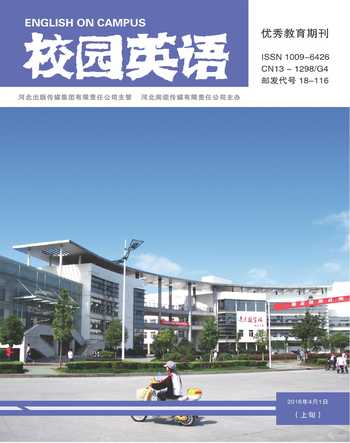Utilization of Information Technology to Assist Translation Teaching
倪宇红
【Abstract】The advance of information technologies has provided educational reform with favorable material conditions and means of support. This paper is an attempt to explore the ways to utilize information technology to facilitate the development of modern translation teaching.
【Key words】information technology; translation teaching
1. Introduction
Translation course is very comprehensive in its nature. The cultivation and enhancement of a student's translating ability relies on various means, which include accumulation of theoretical knowledge, step-by-step practices based on the theoretical knowledge acquired, independent mode of thinking, instructions and guidance by a qualified translation teacher, and communication with other individuals. The utilization of information technology makes many of the means mentioned above become readily available to teachers and students.
2. Learning about domestic and international translation theories and the trends of translation teaching research
Due to various reasons including funds, there exists a lag between the most updated trends in domestic and international translation studies and what we actually get from the traditional printed publications. In order to keep up with the latest development in translation theories, teachers can resort to webpages of domestic or international organizations or blogs of individuals for translation theories in electronic edition. These publications have become a mirror to reflect the trends of current translation theories and can be used for teachers references as well as students complementary materials under the proper guidance and explanation of teachers.
3. Complementing the existing translation teaching materials
The Internet is an all-embracing information storehouse, the content of which includes history, current events, politics, economy, law, art, religion, science and technology, education, and environment, etc. All these are the very treasure for translation teachers when it comes to teaching materials. Therefore, information technology contributes, to a large extent, to the renewal of teaching materials of translation, thus making it closer to the nature and characteristics of the current information era, and helping students have a clearer understanding of current concerns both in terms of translation practice and theories.
4. Promoting exchanges of translation teaching
Telecommunication software such as WeChat or QQ serves as quick and convenient means of communication on the Internet. Students can make good use of these platforms to ask their teachers whenever and wherever they come across a problem, or to discuss some translation questions with their teachers or any other acclaimed scholar anywhere on earth. They will receive feedback soon, which also avoids the possible inconveniences brought about by having to ask questions or discuss issues face-to-face.
It has become an inevitable trend that translators and foreign language learners start seeking help online. Many questions related to translation in various fields are posted online. Guiding students to participate in these discussions will undoubtedly contribute to expanding their range of knowledge. For us teachers, it will help us to determine how to adjust the syllabus in order to foster more translation talents that better meet the increasing demand of the society.
5. Making use of resources which can directly serve the practices of translation teaching
When coming across a new word, the Internet user can look it up on online dictionaries. For example, http://dict.youdao.com/, an online dictionary, can handle searches both from English to Chinese and vice versa. It takes far less time to type in a word and receive an answer on a computer or a smart phone than to look through a paper dictionary; there is immediate access to related data through links; and it is possible to use several dictionaries simultaneously by working with multiple documents. On-line dictionaries organize material for us from their corpus because they are not simply a collection of words in isolation. That is to say, they allow immediate cross-access to information.
Besides, some service providers have collected new word glossaries of both English and Chinese, which are updated regularly on their websites. For instance, the “Language Tips” section of the China Daily offers a daily update of its own online English-Chinese glossary, which is fresh coinages of items or concepts of great influence to the society. Unlike traditional dictionaries that require a very long life cycle to update due to the need of editing and reprinting, such new-type online dictionaries are updated frequently as long as new entries are added. These dictionaries can well be regarded as the ideal references for translators, translation teachers and learners as well.
6. Strengthening synchronous exchange of views on translation teaching among different regions and different schools or colleges through tele-education systems
The Internet has not only created links for people with different cultural backgrounds from different parts of the world, but also has shortened the distance between and among people, making it a reality that people can freely exchange ideas and increase mutual understandings whenever and wherever they are. However, the realization of inter-cultural exchanges does not necessarily mean successful inter-cultural exchanges, since there still exist huge gaps between different cultures and different people. This is a cross-cultural communication obstacle caused by cultural differences. And only by communicating constantly with each other, absorbing each others content, and increasing mutual understanding and tolerance, can we gradually dispel such hindrance. Letting students participate in such cross-cultural communication activities in person contributes to developing students awareness of cross-cultural communication, cultural sensitiveness and the ability of cross-cultural communication. It will be of great advantage to train students, from a cultural perspective, to develop their ability of inter-cultural communication and their skills in translation, be it of literature or any other text style.
7. Conclusion
Education Informatization Development Plan for Ten Years points out education informatization is based on the innovation of education ideas (2011-2020) and depends on the education resources of high quality and the environmental construction of informatized learning. It is, and will remain an endless effort to explore new means and approaches to take full advantage of the opportunities provided by the development of information technology to facilitate translation teaching.
References:
[1]項睿.社交网络应用于辅助大学英语翻译教学的研究[J].湖北经济学院学报(人文社会科学版),2014(9):214-215.
[2]赵巍.浅谈信息技术与翻译人才的培养[J].黑龙江教育(理论与实践),2014(3):19-20.
[3]国家教育信息化发展十年规划(2011-2020年)[DB/OL].

